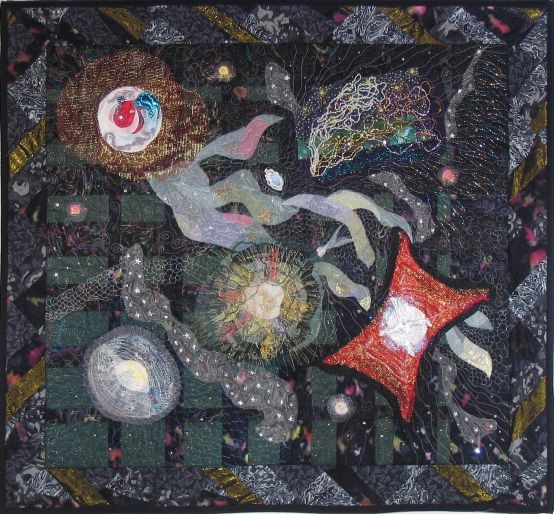di Hermann Hesse
Ora il giorno mi ha affaticato,
il mio fervido desiderio dovrà
serenamente la notte stellata
accogliere, come un bambino stanco.
Mani, lasciate ogni attività,
fronte, dimentica tutti i pensieri;
tutti i miei sensi ora
vogliono sprofondare nel sonno.
E l'anima, non vigilata,
vuole volare su libere ali,
nel cerchio magico della notte
per vivere intensamente mille volte.
Beim Schlafengehen
Nun der Tag mich müd gemacht,
soll mein sehnliches Verlangen
freundlich die gestirnte Nacht
wie ein müdes Kind empfangen.
Hände laßt von allem Tun,
Stirn, vergiß du alles Denken,
alle meine Sinne nun
wollen sich in Schlummer senken.
Und die Seele, unbewacht,
will in freien Flügeln schweben,
um im Zauberkreis der Nacht
tief und tausendfach zu leben.
E' il terzo degli Ultimi quattro Lieder di Richard Strauss.Un sereno accogliere la notte, un quieto scivolare nel sonno, un libero librarsi nell'universo, per continuare a vivere in mille altre forme.
Un Quilt di Galassie e Nebulose

La gloria di colui che tutto move
per l'universo penetra, risplende
in una parte più e meno altrove.
Paradiso, I, 1-3
Lo Hubble Space Telescope ha inviato sulla Terra esaltanti immagini astrali, aprendoci una finestra sui mondi incantati dello spazio remoto. Una donna appassionata di astronomia, Judy W. Ross, ne ha dato un'interpretazione componendo quelle immagini in una "trapunta": come intrecciare il sogno del calore domestico col sogno dei mondi lontani, i più lontani che si possano immaginare.
La nebulosa 'Rettangolo Rosso' e, accanto, la nebulosa 'Eskimo' e poi ... (ma poteva mancare?) la galassia della 'Bella Addormentata'; quindi E V838 Monocerotis, la più misteriosa della Via Lattea in compagnia di un'esplosione cosmica

la N49's Cosmic Blast
e, per chiudere, l'incredibile 'occhio di gatto'


Nessun commento:
Posta un commento